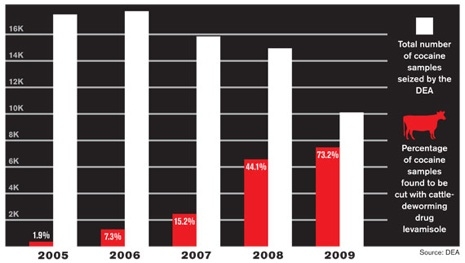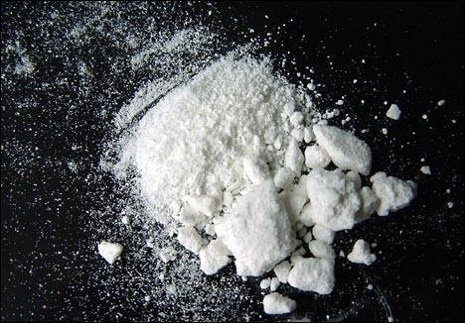
There is a fascinating 3-part series in The Stranger, by investigative reporter Brendan Kiley, that goes in-depth examining how a dangerous new cutting element is being added to the world’s cocaine supply. Levamisole is a medicine used to de-worm livestock, the DEA has reported that nearly 75% of the coke seized in this country during 2009 was cut with levamisole. (In 2005 only 1.9% of the seized cocaine had been cut with levamisole). Levamisole can cause an immune system failure know as “agranulocytosis” leaving users vulnerable to infections and causing skin lesions due to tissue swelling it can cause.
Yuck. If ever there was a time to “just say no” to cocaine (admittedly a drug I’ve never had much of a taste for) now might be the time…
Levamisole is an unusual—and unprecedented—cutting agent because it’s more expensive than other cuts, it makes some customers sick, and it’s being cut into the cocaine before it hits the United States. Smugglers typically prefer to move pure product, which is less bulky and results in less chance of detection. “The Mystery of the Tainted Cocaine” offered a few theories about why South American drug manufacturers (mostly Colombian) are cutting their cocaine with levamisole.
A quick review of those theories:
1. Levamisole might produce a cocainelike stimulant effect either on its own or in conjunction with cocaine (in 2004, racehorses treated with levamisole were found to metabolize the deworming drug into an amphetamine-like stimulant called aminorex), meaning the product could produce a more substantial high with less pure cocaine.
2. Levamisole, unlike other cutting agents, retains the iridescent, fish-scale sheen of pure cocaine, making it easier to visually pass off levamisole-tainted cocaine as pure.
3. Levamisole passes the “bleach test,” a quick street test that reveals cuts like sugar or lidocaine (but, because of a chemical anomaly, not levamisole).
4. Levamisole is a bulking agent for crack. Making crack involves purifying cocaine and washing out the cutting agents, but levamisole molecules slip through this process—meaning a dealer can produce more volume of crack with less pure cocaine.
5. All of the above.
If levamisole can do several of these things, it becomes (in evolutionary terms) an advantageous genetic mutation, a cut that may have started as an accident but showed beneficial properties, so was passed on from one batch of cocaine to the next, from one generation to another, like a new gene.
The evolutionary, all-of-the-above theory is especially compelling because Colombia’s cocaine-production market is so fractured and decentralized, it’s unlikely that one mind is calling all the shots about cocaine’s manufacture and distribution. After the breakup of the Medellín and Cali cartels in the mid-1990s, hundreds (maybe even thousands) of independent cocaine producers leaped into the void. While FARC and the paramilitaries control much of the cocaine trade—such as the camps where Diego worked—they don’t control and centralize production technology to the degree that the Medellín and Cali cartels did.
Meaning: Those hundreds (and maybe thousands) of independent producers must have independently decided to use the same cutting agent. And even if levamisole looks like cocaine, behaves in bleach tests like cocaine, and can bulk up crack in a way that other cutting agents can’t, why not wait to cut it once it has crossed the border?
That’s still a mystery.
As the article also points out, by the time the cocaine reaches the northern city of Seattle, it’s not only been stepped on before it even leaves its south of the border country of origin, but it’s also probably gotten stepped on again and again from stops between San Diego and Sacramento! By the time it gets to Seattle (or London, for that matter) is there even any cocaine left at all in it anymore?
Read more of The Mystery of the Tainted Cocaine by Brendan Kiley (The Stranger)

“Line of cattle dewormer, anyone? Help yourself!”